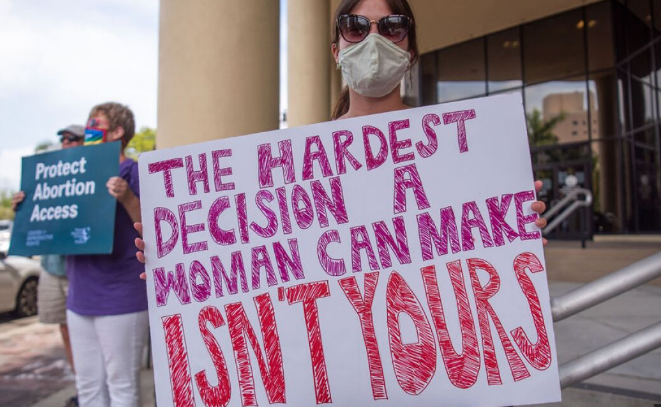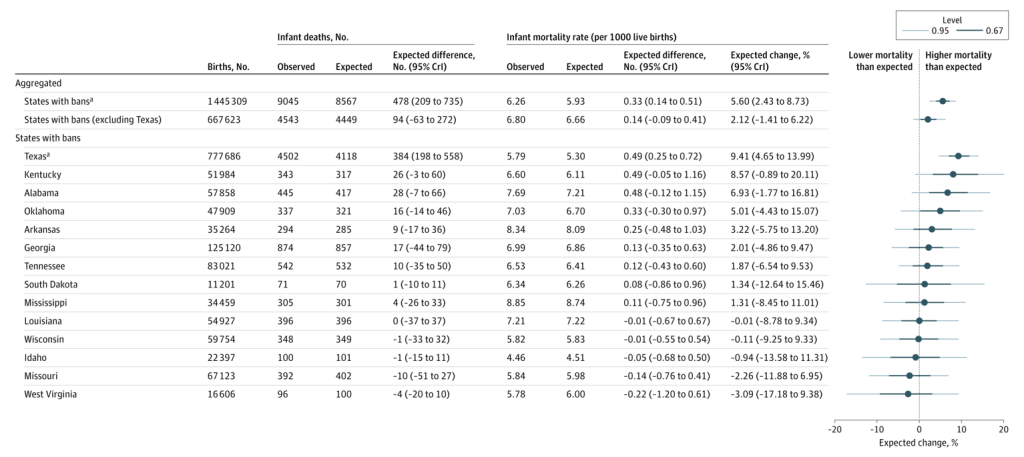
Abortion Bans Lead to a Rise in Infant Mortality
Since Roe v. Wade was overturned the landscape of reproductive health in the United States has shifted dramatically. Abortion bans, once hypothetical are a the reality in many states. While these laws are often framed as protective measures, emerging research suggests they carry unintended and life-threatening consequences—particularly for the most vulnerable among us: infants. A new study analyzing data from 2012 through 2023 reveals a troubling trend: infant mortality rates have risen in states that have implemented complete or 6-week abortion bans.
How Did Infant Mortality Change After Abortion Bans?
Infant mortality—the death of a baby before their first birthday—has been steadily declining in the U.S. for decades. However, this study found that states enacting abortion bans saw a 5.6% relative increase in infant mortality compared to what would have been expected without the bans. This translates to an estimated 478 excess infant deaths across 14 states during the period when these bans were in effect.
The increase was not uniform across all populations. Certain groups—already more vulnerable to poor health outcomes—were disproportionately affected. Black infants experienced an even higher spike in mortality rates, with an 11% increase beyond expected levels. Additionally, states in the South, which already had some of the highest infant mortality rates in the country, saw the largest increases.
Why Would Abortion Bans Lead to More Infant Deaths?
At first glance, it may seem counterintuitive that restricting abortion would lead to more infant deaths. But when we examine the underlying factors, the connection becomes clear:
- Continuation of Nonviable Pregnancies: One of the leading causes of infant mortality is congenital anomalies—severe birth defects that often lead to death within the first year of life. In states without abortion bans, many pregnancies with fatal fetal diagnoses are terminated before birth. When abortion is banned, these pregnancies are more likely to be carried to term, increasing the number of infants who die shortly after birth.
- Limited Access to High-Risk Pregnancy Care: Abortion bans often go hand-in-hand with restrictions on reproductive healthcare in general, including facilities that specialize in high-risk pregnancies. Pregnant individuals in these states may struggle to receive adequate prenatal care, leading to higher rates of preterm birth and complications that contribute to infant mortality.
- Disproportionate Impact on Marginalized Communities: The people most affected by these bans are often those who already face barriers to healthcare—particularly low-income individuals and people of color. Black women are more likely to experience pregnancy complications, and their infants are already more than twice as likely to die in the first year of life compared to white infants. Restricting abortion further compounds these disparities.
The Role of Texas: A Case Study in Policy Impact
Texas, one of the first states to implement a strict 6-week abortion ban, played an outsized role in the study’s findings. Infant mortality in Texas increased significantly after the ban took effect, and because of the state’s large population, its impact heavily influenced national trends. While all states with bans saw increases, Texas’s data suggests that the longer a ban is in place, the more pronounced its effects on infant mortality may become.

What’s Next?
This study provides clear evidence that abortion bans are not just a matter of reproductive rights; they are a public health crisis. The data underscores the urgent need for policymakers to consider the broader health consequences of these laws.
Some key questions remain:
- How will these trends evolve over time as more states implement or further tighten abortion restrictions?
- What policies could mitigate the harms of abortion bans, such as expanded maternal and infant healthcare services?
- Will states with bans invest in better support for high-risk pregnancies, or will these disparities continue to widen?
Join the Conversation
The findings of this study are sobering, but they also present an opportunity for dialogue. What do you think should be done to address rising infant mortality rates? How can we balance policy decisions with public health priorities? Share your thoughts in the comments or on social media—this is a conversation we can’t afford to ignore.
Act Now – Transform Public Health Today!
Don’t wait—join the movement shaping the future of public health. Subscribe for free to get weekly, expert-curated insights and actionable updates.
⚡ Time is critical! Share this blog now and inspire others to be part of this essential mission.



